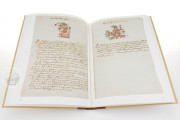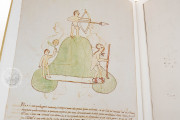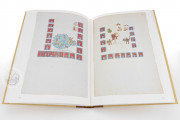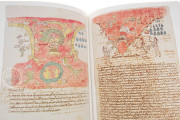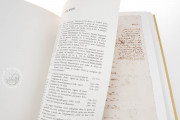The Codex Vaticanus A-Ríos is an important witness to the Spaniards' knowledge in the early colonial period of ancient indigenous Mesoamerican traditions. It was made—or at least begun—in Puebla. Dating from the second half of the sixteenth century and probably created over many years, it is an ethnographic compendium treating Aztec divination rituals, culture, and religious ceremonies. It provides valuable insight into the European interpretation of Aztec religious and cultural life. The manuscript was conceived as a picture book with copious explanatory text: 146 of its 202 pages include painted elements.
There is disagreement among scholars about the extent of direct involvement in the project of the Dominican lay brother Pedro de los Ríos, after whom the manuscript earned part of its nickname. He is credited in the manuscript (in the third person) with having compiled the paintings, and he is even referred to twice in the first person, although none of the Italian-language text—written by more than one scribe—is thought to have come from his pen.
Pictographs Rendered in Traditional Style
The Codex Vaticanus A-Ríos was completed in two phases: first, the images were painted with space left on the page for annotation and commentary. Although the native pictographic style is not practiced with particular assurance, it is thought that the paintings are the work of indigenous artists, although this too has been a subject of scholarly debate.
In keeping with Mesoamerican pictographic tradition, images of figures and objects are outlined in black ink. Areas are filled in with opaque colors emblematic of images in Mexican codices: blue, green, russet, yellow, tan, pink, gray, brown, and red.
A Unique Survival
Notable images include the serpent deity Quetzalcoatl and a pyramid (fol. 7v), a sacrificial scene with figures drawn with light-colored hair (fol. 54v), and women’s costumes (fol. 61r). The celestial layers and underworld levels of the Aztec cosmos occupy the opening facing pages (fols. 1v-2r), important for being the only known image of the Aztec celestial layers.
Extraordinary Prose Commentary
Most postconquest manuscript compendia of ancient Mesoamerican ritual and culture include Spanish-language texts, often brief and sometimes restricted to single-word identifications of pictured deities and other subjects. The Codex Vaticanus A-Ríos stands out for having longer Italian-language commentaries.
Extended Content
In part a close copy of the Codex Telleriano-Remensis, now in Paris, the Codex Vaticanus A-Ríos includes extensive calendrical material with tables and pictographs and explications of festivals. It is remarkable for content not to be found in its principal exemplar or other postcolonial ethnographic compendia. Most important are the sections on cosmological and mythological traditions (fols. 1-11) and ethnography—such as mortuary customs and native dress—(fols. 54-61), which provide insights offered by no other surviving manuscript.
Made for an Italian Dignitary
The manuscript's large scale, neatly written Italian text, and comprehensiveness of content suggest that the Codex Vaticanus A-Ríos was always intended for presentation to an Italian of high rank. It was certainly in the Vatican library by end of the sixteenth century, but it is unknown for certain when it was completed (and whether in Puebla or Italy) or when it entered the collection.
We have 1 facsimile edition of the manuscript "Codex Vaticanus A-Ríos": Codex Vaticanus A (3738) facsimile edition, published by Akademische Druck- u. Verlagsanstalt (ADEVA), 1979
Request Info / Price





